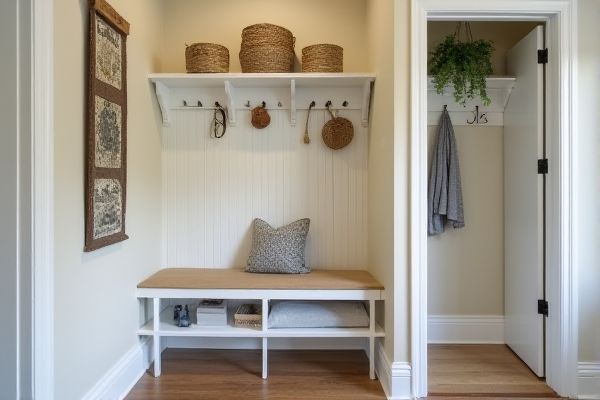
A hall tree combines seating, hooks, and storage to maximize entryway organization, while a mudroom cubby offers individual compartments for shoes, bags, and outdoor gear, focusing on decluttering busy spaces. Discover how each option can improve Your home's functionality and style by reading the rest of the article.
Table of Comparison
| Feature | Hall Tree | Mudroom Cubby |
|---|---|---|
| Primary Use | Entryway furniture for hanging coats, storing shoes, and seating | Organized storage compartments for shoes, bags, and gear |
| Design | Includes hooks, bench, and sometimes mirror or shelves | Grid-like open or closed cubbies, sometimes with bench seating |
| Space Requirements | Compact, ideal for small entryways | Requires larger dedicated mudroom space |
| Storage Capacity | Moderate; suitable for coats, hats, shoes | High; multiple cubbies for individual family member storage |
| Seating | Usually includes built-in bench | May or may not include bench seating |
| Installation | Freestanding or wall-mounted | Built-in or free-standing units |
| Cost | Generally affordable, varies by material | Varies widely; custom-built options more expensive |
| Ideal For | Small homes, apartments, simple entryways | Large homes, families needing organized storage |
Introduction to Hall Trees and Mudroom Cubbies
Hall trees combine seating, storage, and hooks for coats and accessories, offering a multifunctional solution ideal for entryways. Mudroom cubbies provide organized, open compartments designed to store shoes, bags, and outdoor gear efficiently, maximizing space in mudrooms. Both pieces enhance home organization but serve distinct purposes based on storage needs and available space.
Defining Hall Tree: Features and Functions
A hall tree is a multifunctional piece of hallway furniture combining seating, hooks, and storage, designed to organize coats, hats, and shoes efficiently. Its features typically include a bench for sitting, multiple hooks for hanging items, and built-in shelves or cubbies for storing accessories or footwear. Unlike a mudroom cubby, a hall tree often emphasizes both practicality and aesthetic appeal, serving as a stylish focal point in entryways while managing clutter.
What Is a Mudroom Cubby? Key Characteristics
A mudroom cubby is a compact storage solution designed to keep shoes, coats, and accessories organized, often featuring individual compartments or shelves. Its key characteristics include durability, easy access, and the ability to accommodate multiple users by providing personalized spaces. You can maximize entryway functionality with a mudroom cubby by combining its practicality with a streamlined design tailored to your home's needs.
Space-Saving Benefits: Hall Tree vs Mudroom Cubby
Hall trees maximize vertical space by combining seating, storage hooks, and shelves into one compact unit, making them ideal for narrow entryways where floor space is limited. Mudroom cubbies offer organized, individual compartments that efficiently store shoes, bags, and accessories but typically require a larger footprint for optimal use. Choosing a hall tree or mudroom cubby depends on your space constraints and storage needs, with hall trees providing versatile, space-saving benefits for smaller areas.
Aesthetic Appeal: Design Styles and Options
Hall trees often feature traditional or rustic design styles with wood finishes and integrated seating, enhancing entryway aesthetics with a classic charm. Mudroom cubbies typically offer a more utilitarian and modern look, emphasizing clean lines and modular storage options that fit contemporary interiors. Both provide customizable solutions, but hall trees focus on decorative appeal while mudroom cubbies prioritize functional minimalism.
Storage Capacity and Organization Comparison
Hall trees typically offer larger storage capacity with multiple hooks, a bench, and sometimes shelves for shoes, hats, and bags, making them ideal for organizing various items in one compact unit. Mudroom cubbies provide segmented storage designed for individual organization, often featuring open compartments or cubbies tailored for shoes, backpacks, and daily essentials, allowing personalized spaces for multiple users. Choosing between the two depends on whether you prioritize consolidated multifunctional storage or distinct, compartmentalized organization for a busy household.
Ideal Placement: Where Hall Trees and Mudroom Cubbies Work Best
Hall trees are ideal for entryways and small foyers where space is limited, offering a compact solution with hooks, a bench, and storage for coats, hats, and shoes. Mudroom cubbies work best in larger, dedicated mudroom areas or laundry rooms, providing individual compartments that help organize outerwear, backpacks, and sports gear efficiently. Your choice depends on the size and layout of your home, ensuring the storage solution fits the designated space and meets your organizational needs.
Installation and Maintenance Considerations
Hall trees typically require simple assembly and can be freestanding or anchored to the wall for stability, making installation moderately easy with basic tools. Mudroom cubbies often involve built-in or custom installations, demanding precise measurements and professional assistance to ensure durability and seamless integration. Maintenance for both involves regular dusting and occasional tightening of screws, but mudroom cubbies may need more frequent cleaning due to higher exposure to dirt and moisture.
Cost Analysis: Budgeting for Hall Tree or Mudroom Cubby
Hall trees generally cost between $150 and $600, offering a stylish combination of seating, hooks, and storage, making them a versatile choice for entryways. Mudroom cubbies, priced from $300 to $1,200, provide extensive compartmentalized storage ideal for families needing organized spaces for shoes, bags, and outerwear. Budgeting for either requires assessing space, functionality, and long-term durability to ensure the chosen option meets both financial constraints and practical storage needs.
Choosing the Right Option for Your Home
Selecting between a hall tree and a mudroom cubby depends on your home's space and organizational needs. A hall tree combines seating, hooks, and storage in a compact design, ideal for entryways with limited room. Mudroom cubbies offer customizable compartments for shoes, coats, and accessories, perfect for larger spaces requiring more detailed organization.
 homyna.com
homyna.com